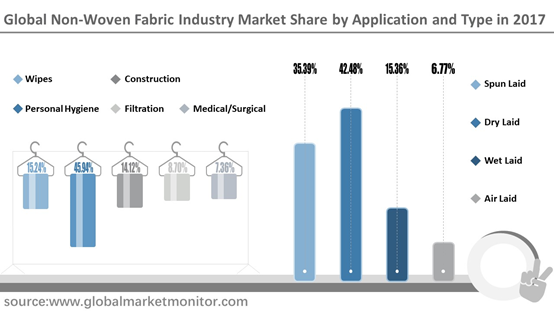Non-woven
fabrics is a thermoplastic material with excellent comprehensive performance,
which is small in density, easy to produce and has low production costs. Often
used as diapers, protective covers, sealed curtains and packaging bags, the
fabric is beautiful, breathable but impermeable, light and comfortable to wear
and durable. It can be widely used in many applications, such as medical and
health industry, family decorates, agricultural, automotive industry, etc.
Non-woven
fabrics can be divided into four types according to the type of production:
spun laid, dry laid, wet laid and air laid. Spun laid nonwovens are made in
one continuous process. Fibers are spun and then directly dispersed into a web
by deflectors or can be directed with air streams. Dry laid nonwovens are formed from
staple fibers into fibers with little mechanical integrity, which are then
bonded by mechanical, thermal or chemical means. The principle of wet laying is
similar to paper manufacturing. The difference lies in the amount of synthetic
fibers present in a wet laid nonwoven. Slurry of water and fiber is deposited
on a moving wire screen, then drained to form a web, squeezed between rollers,
further dehydrated, consolidated and dried, and later impregnated with binder. Air-laid
paper is a textile-like material categorized as a nonwoven fabric made from
wood pulp. Unlike the normal papermaking process, air-laid paper does not use
water as the carrying medium for the fiber, but are carried and formed to the
structure of paper by air.

Our commonly used wipes, that is, disposable cloth used to clean sensitive skin of people, are made of non-woven fabric. Non-woven fabrics are also commonly used to make personal hygiene products to keep the body clean. They are integral components to the homes and buildings and offer many advantages in the construction market. The filtering effect of non-woven fabrics is also very good, which can be used whether to keep the air in home, maintain the operating room sterile, or to remove engine dirt and grit. In addition, nonwovens are extensively used in the medical field and in protection against biological agents in other sectors. Today, with multi-drug resistant strains of bacteria and virus, nonwovens can help in the fight against cross-contamination and the spread of infection in a medical or surgical environment.
Prospect Analysis of Non-Woven Fabric Industry in Various Regions
After a period of development, the non-woven fabric industry is in a mature period, with a fierce competition institution. Companies are mainly from United States and Europe; the industry concentrate rate is very scattered. The top three companies have a market share of 14.39% in 2017, namely Berry Plastics, Freudenberg and Kimberly-Clark Corporation, with revenue market shares of 6.11%, 4.64% and 3.63% respectively.
Europe was the largest revenue market with a market share of 32.08% in 2013 and 28.43% in 2018 with an increase of -3.65%. China ranked the second market with the market share of 25.33% in 2017. Also, the Asia Pacific, Middle East, South America markets for non-woven fabric are expected to be the market with the most promising growth rate. Development of economy, rising per capita income of people, more and more downstream demand has led to an increase of this industry.
Get the Complete Sample, Please Click: https://www.globalmarketmonitor.com/reports/763065-non-woven-fabric-market-report.html
In developing market, with their improvement of health and medical awareness among residents, the improvement of economic income, increase of baby and population, and the improvement of the manufacturing industry which have also stimulated the emergence of technological progress and innovation in the area of nonwovens, many local businesses emerged to the market. In the vertical segment, including hygienic, medical, automotive, filtration, agriculture, and geotechnical materials, the potential of the non-woven material application market has been demonstrated.
In developed market, they have more international companies, good channels, highly market maturity, a highly competent management team, technology and finance advantages, increase investment from enterprises, increase production capacity, introduction of new technologies to their products, increase downstream such as hygiene, agriculture and clothing industry, all of which make a growing market demand for non-woven fabric.
The Application Scope of Non-Woven Fabric Industry Will Expand, with a Broad Market
According to the research, the global non-woven fabric market has a total sales value of 28426.14 M USD back in 2013, and increased to 41403.28 M USD in 2018. We made the prediction that the value of non-woven fabric markets can be 57569.91 M USD by 2023.The CAGR of non-woven fabric is 7.08% from 2017 to 2023.

In the
health care industry, especially in developing markets such as China, the use
of non-woven fabrics has increased due to increasing concern about health of
consumers. In addition, the use of non-woven fabrics in the automobile industry
has also increased, which is expected to promote market growth in the forecast
period. With the rapid technological advancements, nonwoven fabric has
established a large application base in numerous end-user industries, such as
the agricultural and building and construction industries, which, in turn,
boost the market growth.
In the
future, with the continuous emergence of new technologies and the constantly
improvement of the function of non-woven fabrics, the development of non-woven
fabrics will continue to penetrate into new industries, automobiles and other
fields. In the global market, China and India will become the largest markets.
On the
flipside, in the cost structure of non-woven fabric production, the cost of raw
materials, equipment, energy and labor accounts for 75.73%, 5.82%, 4.65% and
8.71% respectively. In the future, some of the materials will facing a fluctuation
price trend, which will lead to a higher cost of non-woven fabric industry, so the
difficulty in procurement of raw materials may become a hint factor to this
industry. In addition, some regions tend to protect local economies and hinder
global trade, which may bring resistance to global market strategies of
manufacturers.
We provide more professional and intelligent market reports to complement your business decisions.